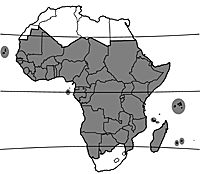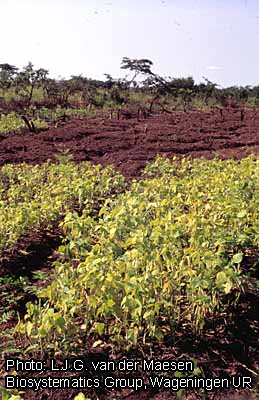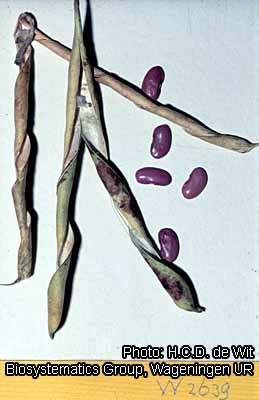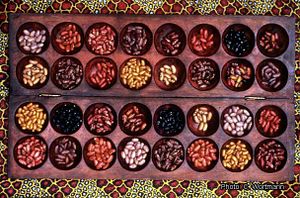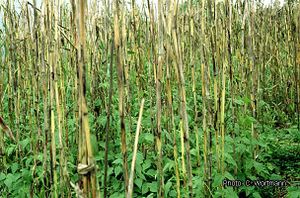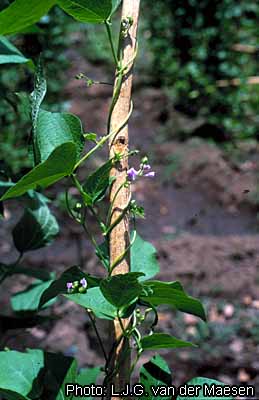Phaseolus vulgaris - common bean (PROTA)
Introduction |
| General importance | |
| Geographic coverage Africa | |
| Geographic coverage World | |
| Cereal / pulse | |
| Vegetable | |
| Medicinal | |
| Forage / feed | |
| Auxiliary plant | |
| Food security | |
Phaseolus vulgaris L. - common bean
- Protologue: Sp. pl. 2: 723 (1753).
- Family: Papilionaceae (Leguminosae - Papilionoideae, Fabaceae)
- Chromosome number: 2n = 22
Vernacular names
- Common bean, haricot bean, kidney bean, navy bean (En).
- Haricot commun, haricot (Fr).
- Feijão, feijoeiro (Po).
- Mharagwe (Sw).
Origin and geographic distribution
Common bean originated in Central and South America. Small-seeded and climbing ecotypes are found in the wild in northern Argentina and Central America. Common bean was independently domesticated in both Central America (Mexico and Guatemala) and in the South American Andes (mainly Peru). The resulting gene pools are distinct. Archaeological evidence indicates that common bean was a domesticated crop already in 6000 and 5000 BC in Peru and Mexico, respectively. Common bean was taken to other parts of the world since the 16th century. Portuguese traders probably introduced common bean to Africa from the 16th century through Sofala (Mozambique), Zanzibar and Mombasa, from where it was carried to higher altitude areas of the interior by slave trading caravans and merchants. Common bean became well established as a pulse crop in parts of Africa before the colonial era. Genetic diversity of common bean and its pathogens and linguistic evidence indicate that it became a major crop in Central African highland areas (e.g. in Rwanda and Burundi) earlier than in other parts of Africa.
Nowadays, common bean is a crop of global importance, especially in North and South America, Europe and Africa. The crop is of significance in many African countries and most intensively grown in the Great Lakes areas of Central Africa. In tropical Africa common bean is a major food crop in urban as well as rural areas.
Uses
The mature dry seeds of common bean are eaten worldwide as a pulse and the immature pods and seeds as a vegetable. In tropical Africa common bean is primarily produced and consumed as a pulse. The nutritional value of the seeds is recognized, but common bean is also important for adding diversity and flavour to carbohydrate-rich meals, such as those based on maize or banana. It is the major protein source in various countries, e.g. in Rwanda, Burundi and Kenya. Although common bean is sometimes recognized as the ‘meat of the poor’, it is also much appreciated by wealthier consumers. In tropical Africa common bean is most typically consumed boiled, often with seasoning and some oil added. It may also be mashed or made into soup. In many parts of the world the dry seeds of common bean are canned, either alone or in tomato sauce.
The leaves of common bean are sometimes eaten as a vegetable, e.g. during the hunger months of the year when not much food is available, but relatively few cultivars have leaves of sufficient tenderness. Crop residues are often used as fodder. In Mali a powder of carbonized seeds is applied to wounds.
In temperate regions of the world Phaseolus vulgaris is mainly grown for the green immature pods (French bean), which are canned, frozen or eaten fresh. In tropical Africa immature pods are mostly produced as a market crop. A separate article in PROTA 2: ‘Vegetables’ deals with vegetable aspects of Phaseolus vulgaris.
Production and international trade
Reliable production statistics for dry common bean are difficult to obtain, as its production is often lumped together with that of other Phaseolus species. In 2000 the annual world production of common bean was estimated by FAO to be 8.3 million t; the largest producer is Brazil. Africa produces about 2 million t annually on about 3.5 million ha. Large producers (100,000–600,000 ha annually) in tropical Africa are DR Congo, Rwanda, Burundi, Ethiopia, Kenya, Uganda, Tanzania, Malawi, Angola and Mozambique; smaller producers (2,000–100,000 ha) are Cape Verde, Niger, Cameroon, Sudan, Zambia and Zimbabwe. Most common bean produced in tropical Africa is consumed by the producer, but 40% may be marketed to supply urban areas and for export with a farm gate value of over US$ 200 million per year. Trade with neighbouring countries is important. For example, significant amounts move from Uganda to Kenya, Rwanda and Sudan, but Uganda may import from these countries when localized deficits occur. An example of longer distance trade of common bean is from Kivu in eastern DR Congo to Kisangani and down the Congo River to Kinshasha. Some common bean production is for specialized export markets, e.g. in Ethiopia for export to Europe and the Middle East, and in northern Tanzania for export to Europe.
Properties
A typical composition of common bean per 100 g edible portion is: water 11.3 g, energy 1218 kJ (291 kcal), protein 21.4 g, fat 1.6 g, carbohydrate 49.7 g, dietary fibre 22.9 g, Ca 180 mg, Mg 180 mg, P 310 mg, Fe 6.7 mg, Zn 2.8 mg, carotene trace, thiamin 0.45 mg, riboflavin 0.13 mg, niacin 2.5 mg, vitamin B6 0.56 mg, ascorbic acid trace (Holland, Unwin & Buss, 1991). The essential amino acid composition per 100 g edible portion is: tryptophan 210 mg, lysine 1540 mg, methionine 240 mg, phenylalanine 1130 mg, threonine 860 mg, valine 990 mg, leucine 1640 mg and isoleucine 890 mg (Paul, Southgate & Russell, 1980). Common bean is deficient in the essential amino acids methionine and cystine. Composition alone is not a reliable indicator of its food value as common bean is not very digestible. Much of the phosphorus is phytate-bound and the protein is only 55–65% digestible. Common bean generally requires a long cooking time and may have ‘hard-to-cook’ properties, which may be due to genetic and environmental factors. Common bean contains antinutritional compounds, such as lectins (haemagglutinins) and trypsin inhibitors, but both are inactivated by proper cooking. It also contains tannins and flatulence-inducing compounds.
Common bean starch has shown cholesterol-lowering effects in rats, whereas lectins have shown in-vitro inhibitory action against HIV-1 reverse transcriptase. A decoction of the pods has shown hypoglycaemic effects in rabbits. Seed coat compounds (methanol extracts, tannin fractions and pure flavonoids) have shown antioxidant activity.
Description
- Climbing, trailing or erect and bushy annual herb, slightly pubescent; taproot well developed, with many lateral and adventitious roots; stem up to 3 m long, angular or nearly cylindrical.
- Leaves alternate, 3-foliolate; stipules triangular, small; petiole up to 15(–30) cm long, grooved above, distinctly thickened at base, rachis (1.5–)2.5–3.5(–6) cm long; stipels small; leaflets ovate, (5–)7.5–14(–20) cm × 5–10(–15) cm, lateral ones asymmetrical, central one symmetrical, entire, slightly pubescent, 3-veined from the base.
- Inflorescence an axillary or terminal false raceme up to 15(–35) cm long, with flowers arranged along the rachis in pairs or solitary.
- Flowers bisexual, papilionaceous; pedicel up to 1 cm long, slender, with ovate bracteoles; calyx campanulate, tube c. 3 mm long, lobes triangular, 2–3 mm long; corolla white to pale purple or red-purple, standard very broadly obovate, hood-shaped, 1–1.5 cm long, wings obovate, c. 2 cm long, keel sharply upturned, c. 1 cm long; stamens 10, 9 fused and 1 free; ovary superior, c. 0.5 cm long, laterally compressed, style upturned and spiralled, with collar of fine hairs below the ellipsoid stigma.
- Fruit a linear pod up to 20 cm long, straight or more commonly curved with a prominent beak, fleshy when immature, green or yellow, sometimes red, purple or with purplish stripes, (2–)5–7(–12)-seeded.
- Seeds globose to kidney-shaped, ellipsoid or oblong, 0.5–1.5(–2) cm long, black, brown, yellow, red or white, sometimes with speckled, flecked or saddled patterns; hilum oblong to elliptical.
- Seedling with epigeal germination; cotyledons oblong, thick; first two leaves simple and opposite, subsequent leaves alternate, 3-foliolate.
Other botanical information
Phaseolus comprises about 50 species, most of them in the Americas. Phaseolus vulgaris is closely enough related to some other Phaseolus species, e.g. Phaseolus coccineus L. (runner bean) and Phaseolus acutifolius A.Gray (tepary bean), to make interspecific hybridization possible.
Andean types of Phaseolus vulgaris tend to have larger seeds and leaves than the Central American types. All growth habits are found in each gene pool, but determinate bush types and climbing types are more common in the Andean than in the Central American pool. In tropical Africa some genetic diversity is found that is not found in the Americas.
Erect bush bean types are most common where mechanical harvest is practised but also in smallholder agriculture. Climbing types are largely restricted to high altitude areas, especially in south-western Uganda, Rwanda, Burundi and eastern parts of DR Congo, but they are also grown in northern and western Malawi, northern and southern Tanzania and northern Zambia. Indeterminate trailing or semi-climbing types are common in most bean growing areas and prevail under growing conditions that are marginal due to high temperatures, water deficits and low soil fertility.
Red, mottled, large-seeded cultivars are most common in tropical Africa, followed by cultivars with red, small to medium-sized seed. Other seed types may comprise 50% of the production. Black-seeded and white-seeded cultivars are not popular because of the colour of the food preparations.
Growth and development
For seed germination of common bean the soil must be warmer than 12°C, with optimal emergence occurring at soil temperatures of 22–30°C. Plant growth habits are broadly grouped into determinate or indeterminate and bush or climbing. Flowering in common bean generally starts 28–45 days after sowing. Self-fertilization is the rule, but with 1–3% outcrossing. Immature pods for vegetable use can be harvested 25–30 days after flowering. The seed-filling period may take 23–50 days. The length of the crop cycle ranges from 60–90 days for determinate types and may be as long as 250–300 days for indeterminate climbing types.
Several Rhizobium species fix nitrogen with Phaseolus vulgaris, including Rhizobium leguminosarum bv. phaseoli, Rhizobium etli and Rhizobium tropici. The nitrogen-fixing ability of common bean is often considered poorer than that of other pulses such as cowpea, soya bean and groundnut, although fixation rates up to 125 kg of N per ha have been recorded.
Ecology
In tropical Africa common bean is well adapted to elevations of 1200–2200 m, with mean temperatures during the growing season of 15–23°C. Still, 20% of the common bean production in tropical Africa takes place at a mean temperature higher than 23°C. The crop can withstand occasional daytime temperatures of 35°C, but this often results in flower abortion. Growth stops below 10°C and the plant is killed by frost. At latitudes higher than 10° Phaseolus vulgaris may be grown at low altitudes during cooler months, generally with irrigation, and usually for immature pod harvest. Common bean production occurs with 250 mm mean rainfall during the growing season but 65% of the production is estimated to occur in areas with an average rainfall higher than 400 mm during the season. Occasional water deficits severely reduce common bean yield. More important constraints than water deficits are diseases that are favoured by humid conditions. Common bean genotypes vary for photoperiod sensitivity (short day plants or day neutral); photoperiod sensitivity is typically greater in genotypes of Andean origin than in Meso-American ones.
Common bean prefers medium-textured, well-drained soils over 0.5 m deep. It is sensitive to soil acidity, including the associated aluminium and manganese toxicities. The optimum pH is 6.0–7.5, but most common bean production in tropical Africa is at soil pH 5–6 and 20% takes place on soils with pH below 5. Common bean production in tropical Africa occurs mostly under conditions of P deficiency. Where Phaseolus species have not grown previously, symbiotic N-fixation may be inadequate to meet the N requirement of the plants.
Propagation and planting
Common bean is normally propagated by seed, but vegetative propagation using stem cuttings is possible. The 1000-seed weight is 150–600 g. Common bean may be sown by broadcasting and row planting. Sole-crop sowing rates range from 150,000–400,000 seeds per ha. With intercropping, sowing rates are less than for sole cropping. Indeterminate climbing common bean is sown 3–6 seeds per planting hole in rows 100–120 cm apart with 40–50 cm spacing within the row. Seeds are normally sown 3–4 cm deep, but as deep as 7 cm if the soil surface is dry and not too heavy or prone to crusting. Often mixtures of different seed types are sown, e.g. in Rwanda, Tanzania and Malawi. In traditional agriculture the land is prepared by hand or animal traction before sowing. Cultivation is mostly on the flat, but sowing on hills or ridges may be practised where the soil is heavy or the groundwater table is high.
Only about 30% of the common bean production area in tropical Africa is planted as a sole crop. Intercropping with maize, banana and root or tuber crops is important with these intercrop associations accounting for 40–50%, 10–20% and 10–20%, respectively, of the common bean production area. Less common is intercropping with sorghum, millet, pea, faba bean, coffee and other crops. Climbing cultivars are more often produced in sole cropping than non-climbing types, but the dense foliage in sole cropping easily creates a humid environment promoting diseases. Common bean is sometimes grown as a relay crop on residual moisture, e.g. in Malawi and southern Tanzania.
Management
For climbing cultivars of common bean, 2 m high poles (usually straight branches or stems of bamboo or Pennisetum) are placed after emergence to support the plants. The crop is usually weeded once or twice, after which its canopy is sufficiently developed to suppress weeds. Earthing-up is often done at about 3 weeks after sowing. This should be done carefully, because common bean is liable to damage to the collar of the plant. Irrigation is uncommon except at higher latitudes with winter (dry season) production. Common bean is rarely fertilized in tropical Africa although N and P deficiencies are major constraints. Adequate P nutrition is important for symbiotic N-fixation and there is often economical response to 20 kg N and 22 kg P per ha. Although much of the common bean production is on acid soils, the use of lime to amend these soils is uncommon. The crop is grown in rotation with other annual or short-lived perennial crops. The rotated crops are typically cereals, other pulses and root or tuber crops.
Diseases and pests
Common bean is extremely susceptible to diseases and pests and more than 50% of the production in tropical Africa is estimated to be lost every year. The seedborne fungal diseases angular leaf spot (Phaeoisariopsis griseola) and anthracnose (Colletotrichum lindemuthianum), and the bacterial diseases common bacterial blight (Xanthomonas campestris pv. phaseoli) and halo blight (Pseudomonas savastanoi pv. phaseolicola, synonym: Pseudomonas syringae pv. phaseolicola) are each among the top constraints of common bean production. Estimated total yield loss attributed to these diseases is more than 1 million t per year in sub-Saharan Africa. Angular leaf spot and anthracnose are sensitive to many fungicides, but smallholder farmers generally do not use chemicals for common bean disease control. Cultivars vary in their reaction to these diseases. Pre- and post-emergence damping off caused by root rot complexes (Pythium aphanidermatum, Rhizoctonia solani (group AG4) and Fusarium solani f.sp. phaseoli) is very important in areas with intensive common bean production and low-fertility soils. Improving nutrient supply and sowing resistant or tolerant cultivars are effective methods of reducing losses to root rot. Bean common mosaic virus (BCMV) is an aphid-transmitted and seedborne virus and has been estimated to cause 180,000 t yield loss per year in sub-Saharan Africa. Resistance to BCMV is controlled by a single dominant gene, but this gene causes susceptibility to bean common mosaic necrosis virus (BCMNV; also known as black root) that is indigenous to Africa. These closely related viruses each have more than one pathogenicity group. Resistance to all groups can be achieved by deploying 2 or more recessive genes. Sowing of disease-free seed can be useful in control of seedborne diseases, but such seed is scarce. Bean rust (Uromyces appendiculatus), Ascochyta blight (Phoma exigua), powdery mildew (Erysiphe polygoni), floury leaf spot and web-blight (Rhizoctonia solani group AG1) together may cause yield losses of 600,000 t/year in sub-Saharan Africa.
The most important insect pests are bean flies or bean stem maggots (Ophiomyia spp.), especially at early growth stages and when plants are stressed by water and nutrient deficits. Bean flies can be controlled by treating seed with a systemic insecticide, such as imidacloprid or endosulphan, either as a seed dust or as a spray shortly after seedling emergence. In Africa cutworms (Agrotis spp.) and caterpillars (Spodoptera spp.) may be a problem especially in soils amended with farmyard manure, a common practice by smallholder growers. Thrips (Frankliniella occidentalis, Frankliniella schultzei and Megalurothrips sjostedti) and pod borers (Helicoverpa armigera, Maruca testulalis and Clavigralla spp.) cause 80,000–90,000 t and 130,000–140,000 t yield loss per year, respectively, in sub-Saharan Africa. Thrips, particularly Frankliniella occidentalis, are difficult to control as they are resistant to many commonly used pesticides. Pod borers are easily controlled by Bacillus thuringiensis products. Aphids (Aphis fabae and Aphis craccivora) are among the top 10 constraints to common bean production and are worse under dry conditions. Ootheca foliage beetle causes widespread damage in sub-Saharan Africa. Whitefly (Bemisia tabaci), a Madagascan bean leaf roller called ‘cigarier’ (Apoderus humeralis) and painted lady (Vanessa cardui, synonym: Pyrameis cardui) are of local importance. Bruchids (Zabrotes subfasciatus and Acanthoscelides obtectus) are major pests of stored common bean and have been attributed with being the sixth main cause of yield loss (250,000 t/year) in sub-Saharan Africa. Pest management typically involves the integration of several low-cost practices including crop rotation, intercropping, sowing of resistant or tolerant cultivars, and insecticide use.
Harvesting
Common bean may be harvested while most pods are still green but near physiological maturity, for an early harvest of a fresh, easy to cook pulse product, but most crops are harvested when mature. In tropical Africa harvesting is nearly all by hand. Non-climbing common bean plants are usually uprooted when most of the pods are dry, bundled, and carried home. Pods of climbing types are normally harvested by hand as they mature, with repeated harvests over several weeks.
Yield
Average common bean yields are about 1.5 t/ha in Europe and industrialized countries of Asia, 1 t/ha in North America and 0.7 t/ha worldwide. Average yields in tropical Africa are often around 0.6 t/ha. Under the best growing conditions, yields of 2.5 and 5 t/ha for non-climbing and climbing types, respectively, are achievable. Under irrigation in Malawi, for instance, yields of 3.8 t/ha have been obtained.
Handling after harvest
Smallholder farmers transport the common bean harvest from the field to their home to be spread on the ground and dried in the sun. After drying, threshing may be by beating with long sticks, driving over heaps of harvested plants with a tractor, or, less commonly, with a threshing machine. Before being stored, common bean seed is often dried in the sun to destroy bruchids and to reduce moisture content for better storage. Prolonged drying can, however, induce a hard-to-cook condition. In some regions seed is sorted to lots of single seed types, while elsewhere complex mixtures of seed types are intentionally produced and consumed. Seeds may be stored with wood ash, tobacco leaves or ash from bean stems.
Genetic resources
Common bean is threatened by genetic erosion due to non-traditional farming practices where relatively few genotypes are produced in pure stands, and, especially in Latin America, to displacement of common bean by more profitable crops. In-situ conservation can be of importance especially in countries like Rwanda where many landraces are found under diverse conditions and where they are often grown in complex mixtures of as many as 20 seed types.
The largest ex-situ collection of Phaseolus is at the International Center for Tropical Agriculture (CIAT) near Cali, Colombia. It holds over 40,000 accessions of which over 35,000 are of Phaseolus vulgaris. This was estimated to account for 50–75% of the variability occurring in the centres of diversification for domesticated types, but only less than 30% of diversity of wild types. Germplasm collections held in Africa include: Bunda Agricultural College, Lilongwe, Malawi (6000 accessions), National Genebank of Kenya, KARI, Kikuyu (3000 accessions) and Institut des Sciences Agronomiques du Rwanda, Butare (3000 accessions). African national breeding programmes (e.g. in Uganda) have smaller landrace collections.
Breeding
Common bean breeding programs in Africa and elsewhere have as their goal to improve yield potential; much of the progress is through improved tolerance or resistance to biotic and abiotic constraints. Improved resistance to diseases has been the main breeding goal and much success has been achieved, although resistance is often not durable due to genetic diversity and adaptive ability of the pathogens. Resistance to common bacterial blight has been introduced from Phaseolus coccineus and Phaseolus acutifolius. Improved insect resistance has been another major breeding goal. Wild Phaseolus species have been useful sources of genes, such as for resistance to the bruchid Zabrotes subfasciatus. Breeding for tolerance to abiotic stresses has gained in importance and lines with superior tolerance to acid soils, and others efficient in N or P use, have been released in Africa. Promising progress in breeding for drought tolerance is being achieved where deep root systems are combined with efficient transport of carbohydrates from leaves to seed under drought stress. Progeny produced from crosses between the Andean and Meso-American gene pools typically is weak and of low productivity, but breeders have developed superior lines and parents through inter-pool crosses which have superior traits from each pool.
Resource-constrained breeding programmes in Africa have benefited from regional and international collaborative efforts, such as from germplasm generated at CIAT.
Efficiency of breeding common bean is improving with increased use of molecular markers. The ‘Phaseomics’ initiative facilitates collaboration among research institutions in the development of a cDNA library and sequencing of the common bean genome. In-vitro regeneration of common bean for breeding purposes is possible using different explants, including shoot tips, petioles, seedlings, embryonic axes, cotyledons, seedling nodes and meristematic calli. No confirmed reports exist of stable transgenic common bean plants based on Agrobacterium tumefaciens systems, but transgenic plants have been obtained by particle bombardment. However, the most efficient way to improve common bean with gene technology is probably to use Phaseolus acutifolius, which can be routinely transformed using Agrobacterium, and to cross the resulting transgenic plants with common bean using embryo rescue techniques.
Prospects
Common bean is the most consumed pulse globally and a very important crop in tropical Africa, especially in Central, East and southern Africa, both for its nutritional value and its market potential. It is especially important to smallholder farmers and women, who often are responsible for the common bean crop. Regional trade of common bean is of economic significance for some countries and there is also some common bean production in tropical Africa for export to Europe and the Middle East. There is no reason to expect that the importance of common bean will decrease in the future; in tropical Africa the demand is even likely to increase as population increases. Common bean production in tropical Africa is constrained by susceptibility to diseases and pests. Breeding for resistance to or tolerance of diseases and pests has achieved considerable progress, but work remains to be done as resistance is often not durable. Breeding for better tolerance to abiotic stresses, such as aluminium toxicity, and for more efficient use of inadequate soil water and nutrients, is also necessary to improve production both on marginal and on productive soils. Biotechnological tools will play an increasingly important role in common bean breeding, e.g. the use of molecular mapping to locate resistance genes.
Major references
- Abate, T. & Ampofo, J.K.O., 1996. Insect pests of beans in Africa: their ecology and management. Annual Review of Entomology 41: 45–73.
- Allen, D.J., Buruchara, R.A. & Smithson, J.B., 1998. Diseases of common bean. In: Allen, D.J. & Lenné, J.M. (Editors). The pathology of food and pasture legumes. CAB International, Wallingford, United Kingdom. pp. 179–265.
- Baudoin, J.P., Vanderborght, T., Kimani, P.M. & Mwang’ombe, A.W., 2001. Common bean. In: Raemaekers, R.H. (Editor). Crop production in tropical Africa. DGIC (Directorate General for International Co-operation), Ministry of Foreign Affairs, External Trade and International Co-operation, Brussels, Belgium. pp. 317–326.
- Gepts, P. & Debouck, D., 1991. Origin, domestication, and evolution of the common bean. In: van Schoonhoven, A. & Voysest, O. (Editors). Common beans: research for improvement. CIAT, Cali, Colombia and CAB International, Wallingford, United Kingdom. pp. 7–54.
- Hidalgo, R., 1991. CIAT’s world Phaseolus collection. In: van Schoonhoven, A. & Voysest, O. (Editors). Common beans: research for improvement. CIAT, Cali, Colombia and CAB International, Wallingford, United Kingdom. pp. 163–198.
- Messiaen, C.-M. & Seif, A.A., 2004. Phaseolus vulgaris L. (French bean). In: Grubben, G.H.J. & Denton, O.A. (Editors). Plant Resources of Tropical Africa 2. Vegetables. PROTA Foundation, Wageningen, Netherlands / Backhuys Publishers, Leiden, Netherlands / CTA, Wageningen, Netherlands. pp. 415–419.
- Popelka, J.C., Terryn, N. & Higgins, T.J.V., 2004. Gene technology for grain legumes: can it contribute to the food challenge in developing countries? Plant Science 167: 195–206.
- Shellie-Dessert, K.C. & Bliss, F.A., 1991. Genetic improvement of food quality factors. In: van Schoonhoven, A. & Voysest, O. (Editors). Common beans: research for improvement. CIAT, Cali, Colombia and CAB International, Wallingford, United Kingdom. pp. 649–678.
- Smartt, J., 1989. Phaseolus vulgaris L. In: van der Maesen, L.J.G. & Somaatmadja, S. (Editors). Plant Resources of South-East Asia No 1. Pulses. Pudoc, Wageningen, Netherlands. pp. 60–63.
- Wortmann, C.S., Kirkby, R.A., Eledu, C.A. & Allen, D.J., 1998. Atlas of common bean (Phaseolus vulgaris) production in Africa. CIAT Publication 297. CIAT, Cali, Colombia. 133 pp.
Other references
- Beninger, C.W. & Hosfield, G.L., 2003. Antioxidant activity of extracts, condensed tannin fractions, and pure flavonoids from Phaseolus vulgaris L. seed coat color genotypes. Journal of Agricultural and Food Chemistry 51(27): 7879–7883.
- Chacon, S., M.I., Pickersgill, B. & Debouck, D.G., 2005. Domestication patterns in common bean (Phaseolus vulgaris L.) and the origin of the Mesoamerican and Andean cultivated races. Theoretical and Applied Genetics 110(3): 432–444.
- Debouck, D.G. & Smartt, J., 1995. Beans. In: Smartt, J. & Simmonds, N.W. (Editors). Evolution of crop plants. 2nd Edition. Longman, London, United Kingdom. pp. 287–294.
- Freytag, G. & Debouck, D.G., 2002. Taxonomy, distribution and ecology of the genus Phaseolus (Leguminosae - Papilionoideae) in North America, Mexico and Central America. Botanical Institute of Texas, Fort Worth, Texas, United States. 300 pp.
- Fukushima, M., Ohashi, T., Kojima, M., Ohba, K., Shimizu, H., Sonoyama, K. & Nakano, M., 2001. Low density lipoprotein receptor mRNA in rat liver is affected by resistant starch of beans. Lipids 36(2): 129–134.
- Giller, K.E., 2001. Nitrogen fixation in tropical cropping systems. 2nd Edition. CAB International, Wallingford, United Kingdom. 423 pp.
- Gillett, J.B., Polhill, R.M., Verdcourt, B., Schubert, B.G., Milne-Redhead, E., & Brummitt, R.K., 1971. Leguminosae (Parts 3–4), subfamily Papilionoideae (1–2). In: Milne-Redhead, E. & Polhill, R.M. (Editors). Flora of Tropical East Africa. Crown Agents for Oversea Governments and Administrations, London, United Kingdom. 1108 pp.
- Graham, P.H. & Ranalli, P., 1997. Common bean (Phaseolus vulgaris L.). Field Crops Research 53: 131–146.
- Hanelt, P. & Institute of Plant Genetics and Crop Plant Research (Editors), 2001. Mansfeld’s encyclopedia of agricultural and horticultural crops (except ornamentals). 1st English edition. Springer Verlag, Berlin, Germany. 3645 pp.
- Hidalgo, R. & Beebe, S., 1997. Phaseolus beans. In: Fuccillo, D., Sears, L. & Stapleton, P. (Editors). Biodiversity in trust: conservation and use of plant genetic resources in CGIAR centres. Cambridge University Press, Cambridge, United Kingdom. pp. 139–155.
- Holland, B., Unwin, I.D. & Buss, D.H., 1991. Vegetables, herbs and spices. The fifth supplement to McCance & Widdowson’s The Composition of Foods. 4th Edition. Royal Society of Chemistry, Cambridge, United Kingdom. 163 pp.
- Johnson, N.L., Pachico, D. & Wortmann, C.S., 2003. The impact of CIAT’s genetic improvement research on beans. In: Evenson, R.E. & Gollin, D. (Editors). Crop variety improvement and its effect on productivity: the impact of international agricultural research. CABI Publishing, Wallingford, United Kingdom. pp. 257–274.
- Kay, D.E., 1979. Food legumes. Crops and Product Digest No 3. Tropical Products Institute, London, United Kingdom. 435 pp.
- Mackinder, B., Pasquet, R., Polhill, R. & Verdcourt, B., 2001. Leguminosae (Papilionoideae: Phaseoleae). In: Pope, G.V. & Polhill, R.M. (Editors). Flora Zambesiaca. Volume 3, part 5. Royal Botanic Gardens, Kew, Richmond, United Kingdom. 261 pp.
- Martínez Romero, E., 2003. Diversity of Rhizobium - Phaseolus vulgaris symbiosis: overview and perspectives. Plant and Soil 252: 11–23.
- Paul, A.A., Southgate, D.A.T. & Russell, J., 1980. First supplement to McCance and Widdowson’s The composition of foods: amino acids (mg per 100 g food), fatty acids (g per 100 g food). Elsevier, Amsterdam, Netherlands. 112 pp.
- Qi, A., Smithson, J.B. & Summerfield, R.J., 1998. Adaptation to climate in common bean (Phaseolus vulgaris L.): photothermal flowering responses in the eastern, southern and Great Lakes regions of Africa. Experimental Agriculture 34(2): 153–170.
- Roman-Ramos, R., Flores-Saenz, J.L. & Alarcon-Aguilar, F.J., 1995. Anti-hyperglycemic effect of some edible plants. Journal of Ethnopharmacology 48: 25–32.
- Wang, H.X. & Ng, T.B., 2000. Examination of lectins, polysaccharopeptide, alkaloid, coumarin and trypsin inhibitors for inhibitory activity against Human Immunodeficiency Virus reverse transcriptase and glycohydrolases. Planta Medica 67(7): 669–672.
- Westphal, E., 1974. Pulses in Ethiopia, their taxonomy and agricultural significance. Agricultural Research Reports 815. Centre for Agricultural Publishing and Documentation, Wageningen, Netherlands. 263 pp.
Sources of illustration
- Smartt, J., 1989. Phaseolus vulgaris L. In: van der Maesen, L.J.G. & Somaatmadja, S. (Editors). Plant Resources of South-East Asia No 1. Pulses. Pudoc, Wageningen, Netherlands. pp. 60–63.
Author(s)
- C.S. Wortmann, Department of Agronomy and Horticulture, University of Nebraska Lincoln, IANR, 154 Keim Hall, Lincoln, NE 68583–0915, United States
Correct citation of this article
Wortmann, C.S., 2006. Phaseolus vulgaris L. (common bean) In: Brink, M. & Belay, G. (Editors). PROTA 1: Cereals and pulses/Céréales et légumes secs. PROTA, Wageningen, Netherlands. Accessed 18 December 2024.
- See this page on the Prota4U database.

